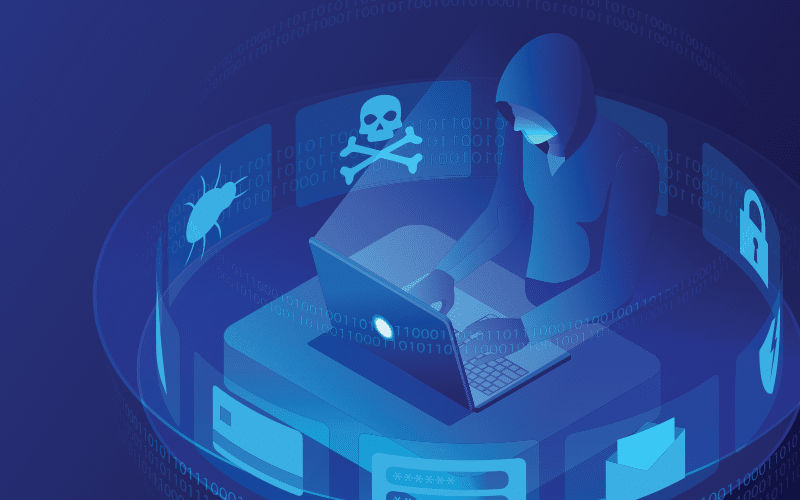There are plenty of different types of cyberattacks that bad actors can leverage against your digital infrastructure. The specific attacks targeting your organization will likely vary based on factors like the size of your company (number of employees and/or revenue) as well as the industry you operate within. In this article, we focus on some of the most common cyberattacks that should be on every organization’s radar.

Insider threats
Most network attacks originate from outside an organization, which is why so many security teams fixate on stopping external adversaries. However, a holistic cybersecurity strategy also addresses malicious activities that originate from within an organization. These are known as insider threats. An insider threat is usually a former or current employee or a vendor with access to an organization’s network and devices.
Insider threats are especially dangerous and difficult to stop for two reasons. First, the perpetrator usually has extensive knowledge of an organization’s security policies, business processes, and response strategies. Additionally, an insider can often circumvent cybersecurity measures and directly access the network. The fallout from a successful insider attack is especially worth noting: recent research shows often up to five times more data is stolen in this type of breach.
While the most damaging insider threats stem from malicious employees or former employees, they can also result from negligence. For instance, a forgetful employee may use the same password for their business applications and their personal email address or other personal applications. If a cybercriminal obtains their personal information, that individual may also be able to gain access to your network.
According to Verizon’s 2023 Data Breach Investigations Report, about one-fifth of cybersecurity incidents involve insider threats, whether intentional or unintentional in nature. To prevent negligence-driven insider threats, your organization should assume a zero trust approach, implement strict password requirements, and enforce other protections, like multi-factor authentication (MFA). You should also provide employees with comprehensive training on cybersecurity best practices. A well-trained staff can be one of your greatest allies in the fight to protect your data.

Supply chain attacks
Supply chain attacks seek to disrupt your operations by targeting third-party vendors or software providers. Hardware supply chain attacks focus on compromising physical assets, such as devices, machinery, etc. Software supply chain attacks are directed at applications. Once an app is injected with malicious code, it can infect your entire user base.
Attacking supply chain hardware can be quite challenging. However, software supply chain attacks are relatively easy to perpetrate. This is because many software solutions use widely-available third-party application programming interfaces (APIs). Apps built on proprietary or open-source code are also especially vulnerable to these threats. The most widely known example of a software supply chain attack is the SolarWinds attack, which wreaked havoc on SolarWinds and its 18,000 private business and public sector customers.
With the right solution, you can continuously check whether user credentials, including your vendors’, have been stolen in third-party data breaches and are circulating in criminal marketplaces. By identifying compromised credentials and remediating them early, you strip them of any value to criminals.

Account takeover attacks
Account takeover attacks are both widespread and difficult to detect. To perpetrate these identity-based attacks, a malicious actor will steal, buy, or guess an individual’s credentials, such as their email address, username, and password, and use them to log into the user’s accounts, masquerade as them, steal data, and perform other malicious acts. Once the bad actor has gained access, this is known as account takeover.
Account takeover attacks are hard to detect because the criminal logs into the network using legitimate credentials. As a result, IDS software, firewalls, and other preventive measures will only alert network managers to the activity if they notice irregular behavior or activity. This type of access can go undetected for months.
For many organizations, it’s important to think about account takeover from both an employee and consumer lens. SOC teams need to have measures in place for exposed employee credentials and PII, as well as regularly check for exposed customer credential matches to be able to enforce step-up authentication or password resets.

Spoofing
Spoofing occurs when a cybercriminal disguises themselves as a business or trusted entity and attempts to earn the victim’s trust for the purpose of stealing money or valuable information. There are several types of spoofing, including:
Domain spoofing
In domain spoofing, attackers will impersonate known websites or businesses. The fake site’s domain name will closely resemble the legitimate one, and the website will have branded content meant to deceive users.
SMS spoofing
SMS or text spoofing involves an attacker impersonating a trusted source like a government agency or bank. The attacker will send an SMS message that will typically serve as a phishing attempt via a link to a fake website or attachment that contains malware.
Email spoofing
Email spoofing targets businesses by sending them emails with forged addresses. Since the recipient is familiar with the sender, they are more likely to click on any links or attachments the email contains.
To protect your organization from spoofing, it’s important to train users to carefully read URLs, domain names, and email addresses to make sure they are free from typos or other inconsistencies. Organizations should also leverage services that can auto-detect email spoofing.

Phishing
Phishing involves using social media, text messages, or email to trick a victim into sharing sensitive data. Typically, phishers want to obtain account numbers or passwords. Alternatively, they may attempt to trick the user into downloading a malicious file.
During a phishing attempt, a cybercriminal may spoof your IT department’s help desk email address and inform you that you are locked out of your account. In the message, they will likely ask you to download a link with instructions on how to reset your password. Alternatively, they may ask you for your password so they can “reset it.”
A successful phishing attempt in which an attacker gains access to a victim’s company email account can, in turn, lead to business email compromise (BEC), when the attacker leverages the account to create convincing-looking phishing emails in the victim’s own writing style, tricking customers, partners, or colleagues into thinking the phish is a legitimate email from a trusted source. One employee’s compromised business email account can quickly put enterprise data, funds, intellectual property, and brand reputation at risk.

Malware attacks
Malware is a broad phrase that refers to any code or program created to harm a server, network, or device. There are many types of malware, including:
- Ransomware
- Fileless malware
- Adware
- Spyware
- Worms
- Keyloggers
- Infostealers
Of these, ransomware is at the top of most cyber leader’s list of concerns. In a ransomware attack, perpetrators will encrypt your business data and threaten to hold it hostage until you pay the ransom. The WannaCry ransomware attack was a major cyberattack that exploited a vulnerability in Windows and then encrypted local hard drives on a large number of high-profile systems globally. The Colonial Pipeline attack is another well known example of a ransomware attack.
Interestingly, new research shows a direct connection between infostealer malware infections and follow-on ransomware attacks. An analysis of a data sample in SpyCloud’s latest Ransomware Defense Report found that one-fifth of ransomware attacks were preceded by an infostealer infection in 2023, and that certain infostealer infections increased the likelihood of a future ransomware attack even further.
Fortunately, a robust cybersecurity strategy that includes leveraging third-party breach and malware-exfiltrated data from the darknet to remediate exposures can help you safeguard your organization and prevent ransomware and other attacks.

Denial-of-service (DoS) attacks
A denial-of-service (DoS) attack floods your network with false requests to disrupt operations. During a DoS attack, your team cannot perform rudimentary tasks like viewing online accounts, visiting websites, or accessing their email. Although a DoS attack typically won’t lead to data loss, it can still cost your company substantially in lost productivity.
Distributed Denial of Service (DDoS) attacks are similar to DoS attacks. However, a DoS attack originates from only one system, whereas a DDoS event is launched from several applications simultaneously. As a result, DDoS network attacks are harder to stop and will take your network down much faster than a standard DoS attack.
DoS and DDoS attacks are often carried out as part of a larger extortion plan, targeting enterprise websites or other resources to get an organization’s attention – for example, as part of a ransom request.

Session hijacking
Session hijacking is an emerging type of cyberattack that exploits modern authentication practices. Session hijacking takes advantage of stolen web session cookies or tokens, exfiltrated by malware, and allows a bad actor to take over a user’s web session. Because it allows the attacker to access an already-authenticated session, it bypasses the need for login credentials, MFA, and even passkeys. Session hijacking is a new entry point in criminals’ arsenal for carrying out malicious activity like fraud and ransomware attacks.
Bolster your cybersecurity defenses with Cybercrime Analytics from SpyCloud
In the ever-evolving cybersecurity landscape, bad actors are constantly testing out both new and old types of cyberattacks to breach defenses and steal data. To effectively stop malicious activities before they become a big problem for your organization, deploying a comprehensive cybersecurity strategy that is powered by what criminals know about your business and your customers By fortifying your defenses with the same data in criminals’ hands, you can better protect your valuable digital assets and maintain the cyber resilience of your organization’s infrastructure.
SpyCloud can help you pinpoint and remediate possible vectors for a variety of cyberattacks before it’s too late.
To learn more, request a demo with SpyCloud and tighten your security stance today.



